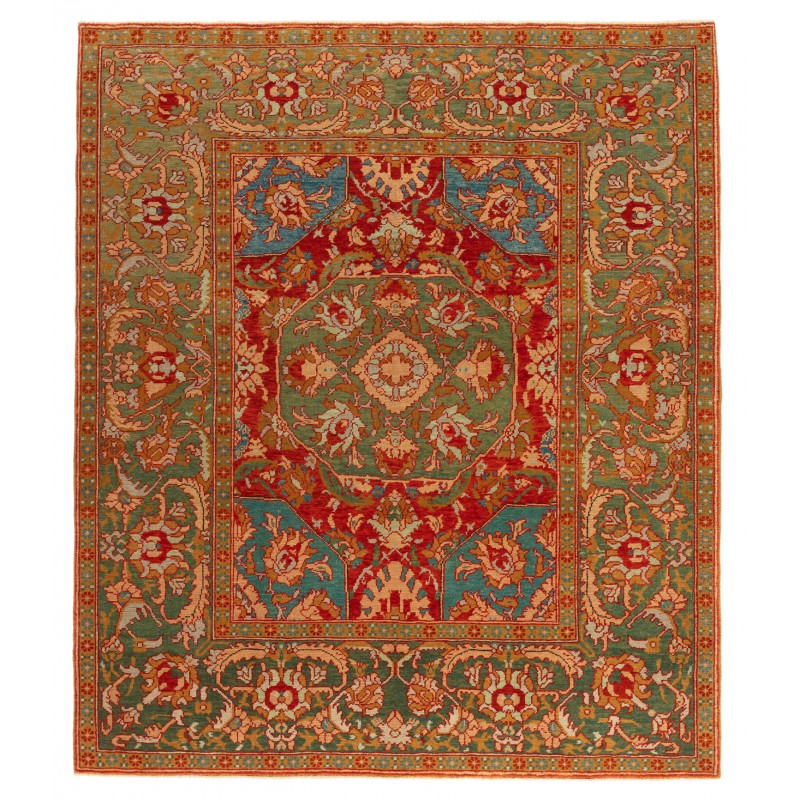
- Stock: In Stock
- Model: C40079
- サイズ: 126cm x 146cm
- SKU: ART89
16世紀にオスマン帝国がエジプトの工房で設立したカイロの製造工場で織られたトルコ宮廷製絨毯です。これらの絨毯は、おそらくイスタンブールで作られ、当時カイロに送られた紙のカートゥーンに従ってエジプトで織られました。
この絨毯の情報は、Wilhelm von BodeとErnst Kühnelの著書『近東の古い絨毯』(Klinkhardt&Biermann、ベルリン、1958年、76ページ)から得られています。オスマン帝国による征服の直後(1517年)、エジプトではスタイルの変化がありました。イスタンブールの宮廷のために働く工場が設立されたことにより、絨毯産業で強力な表現を見せました。カイロのオスマン帝国の絨毯は、前の時代の絨毯と材料およびカラーレンジで一致し、パレットは黄色、白色、および他のわずかな色の使用が増えることでのみ拡張されました。ただし、時折、カイロの基本的な3つの色に満足する傾向もありました。それにもかかわらず、製作の継続性に関して疑問が呈された場合、それは新しい絨毯が完全にこれまでの装飾的な方向性を放棄したという事実に基づいていました。植物は時に自然主義的で、独特のスタイルでスタイライズされ、豊富に配置され、トルコの壁タイルやブロケードで知られる形状が、広がりを持ってフィールドを埋め尽くし、しばしば角に繰り返される大きなまたは小さなメダリオンによって中断されます。カーネーション、チューリップ、ヒヤシンス、ユリ、牡丹などの花々は、優雅な弧を描く葉、豪華なヤシの木の葉、繊細な花の束とともに、これらの絨毯の豊かな植物群を構成しています。そのボーダーは、エレガントな角の解決策で目を楽しませます。同時に、ガードストライプではほぼ常に小さなバラの花が一列に現れます。マムルークの伝統に基づいた借用がまだ見られることは稀であり、一方で、デコレーションの将来の革命は、私たちがまだ以前のグループに属すると数えるいくつかのサンプルで既に予告されています。純粋な民衆芸術では、このような根本的な変革は考えられませんが、工場の運営では、完全に新しいプログラムの導入は最小限の混乱で実現できます。この方向性の変化に伴い、異なる概念であっても、統率するメダリオンのアイデアが既に使用されていたことは重要でした。この絨毯のデザインは解釈され、柔らかな色がデザイナーによって選ばれています。
Turkish Court Manufactury Rugs were woven in the Egyptian workshops founded by Ottoman Empire in the 16th century. Those carpets were woven in Egypt, following the paper cartoons probably created in Istanbul and sent to Cairo at that time.
The source of carpet comes from the book Antique Rugs from the Near East, by Wilhelm von Bode and Ernst Kühnel, Klinkhardt & Biermann, Berlin 1958, pg.76. Shortly after its conquest by the Osmanli Turks (1517), a change of style was set in Egypt which, due to the establishment of a manufactory working for the court in Istanbul, found a powerful expression in the carpet industry. The Cairene Ottoman carpets correspond with those of the previous period both in material and in color range, and the palette is extended only through the more plentiful use of yellow, white, and a few other tints; occasionally, however, they were inclined to be satisfied with the three Cairene basic colors. Nevertheless, if there have been doubts expressed regarding the continuity of their production, these were based entirely upon the fact that the new rugs completely renounced the decorative orientation which had been observed up to that point. Vegetation which at times is naturalistic, stylized in a peculiar manner, is deployed luxuriantly and, in forms that are known to us from Turkish wall tiles and brocades, quite fills the field in endless continuation, interrupted by a large or a small medallion, quadrants of which are often repeated in the corners. Carnations, tulips, hyacinths, lilies, peonies, and other flowers, together with gracefully sweeping lancet leaves, sumptuous palmettes, and delicate sprays of blossoms, constitute the rich flora of these carpets, whose borders charm the eye with their elegant solutions for the corner problem. At the same time, in the guard stripes almost invariably little rosette flowers appear all in a row. It is merely by way of exception that we will still find appropriations levied upon the Mamluk tradition, while, on the other hand, the coming revolution in decor is already heralded in a few specimens which we still count as belonging to the earlier group. In pure folk art, such a radical overturn would be quite inconceivable, but then in the operation of a manufactory, the introduction of a completely novel program can be accomplished with a minimum of confusion. With this change of orientation, it was significant that the idea of a governing medallion, even if with a different conception, had already been put to use. The design of this carpet is interpreted and soft colors are chosen by our designers for this carpet.
